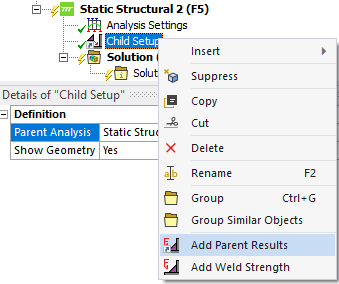 Weld Child Setup
Weld Child Setup
About
The Weld Child Setup let you re-use the Add Welds Group setup from one linked parent structural (or thermal) analysis.
If updating the weld setup in the parent analysis the linked setup will automatically get the new data.

Usage
Click on “Weld Child Setup” in the toolbar to insert the Weld Child Setup in the current static analysis. It is not possible to combine a Weld Child Setup and other Add Welds Groups in the same analysis. It is therefore not possible to add a Weld Child Setup if other active Add Welds Groups exist (or the opposite).
A Weld Child Setup can be added to a Random Vibration or Response Spectrum analysis to display the Welds used in the Modal analysis and to add result objects using the context action.
Inputs to define the Weld Child Setup are:
| Definition | |
|---|---|
| Parent Analysis | Select an analysis from all linked analyses that contain Add Welds Groups objects. |
| Show Geometry | Yes (Default)/No. Enable Group view of all group children. |
After adding the Weld Child Setup the model can be solved using the Add Welds Groups setup of the Parent Analysis.
The Weld Child Setup will not be aware if the parent weld objects are modified and “invalidate” the current solution. You must manually clear the analysis with the Weld Child Setup and re-run the analysis to get the new properties.
The parent analysis must have at least one Fillet/Butt Welds Group (but it does not need to have any children) to be identified.
To re-use the weld results from the parent analysis after adding the Weld Child Setup use the context action: “Add Parent Results”.
To add default results use the context action: “Add Weld Strength”.

To re-use the weld results from the parent analysis (or another analysis) after adding the Weld Child Setup first select the analysis and click Save Weld Configuration. Then select the child analysis and click Import Weld Configuration and browse to the parent working directory. In this way the results will be linked to the correct load objects.
Graphics
The Weld Child Setup displays all butt and fillet weld objects from the selected parent analysis.